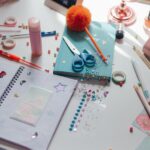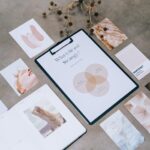As you select, sketch, and strategize, creating your fashion design portfolio online becomes a journey of showcasing your creativity, organizing your masterpieces, and captivating your audience. You're about to embark on a process that not only highlights your skills but also positions you strategically in the competitive world of fashion. This guide will walk you through every step, from the initial gathering of your work to the final presentation in a sleek, digital format. You'll learn how to choose the right projects, design an engaging layout, and select the best platform to display your portfolio. But beyond the basics, you'll discover insider tips on optimizing your portfolio's online presence and ensuring color accuracy, all while keeping your files organized and easily accessible. Let's not forget, the fashion industry evolves rapidly, and so should your portfolio; hence, understanding how to update and refresh your content will keep you relevant. Now, if you're wondering how exactly you can achieve all this and truly stand out, you're in the right place.
Key Takeaways
- Curate a portfolio that showcases creativity and understanding of industry trends
- Choose a platform that enhances visual appeal and includes a mood board
- Use consistent layout and design elements throughout the portfolio
- Safeguard your fashion portfolio with reliable backups
Portfolio Essentials
Before diving into the vibrant world of fashion design, it's crucial to master the art of curating a portfolio that not only showcases your creativity but also highlights your understanding of the industry's fast-paced trends. To create a fashion portfolio that stands out, start by organizing your content and sketching out a layout that tells your unique story. Look for Fashion Portfolio Examples that inspire and guide you in crafting a professional and polished presentation.
Choosing the right platform is essential for crafting a digital version of your portfolio. Optimize it with software that enhances your work's visual appeal. Your fashion portfolio website should not just showcase your best designs but also include a mood board that reflects your creative process and inspiration. This digital space is where you Include in Your Fashion narrative, blending your personal brand with your design ethos.
Choosing Your Platform
Having highlighted the essentials of curating a standout fashion portfolio, it's time to focus on selecting the ideal platform that aligns with your creative vision and professional aspirations. The ultimate guide for creating your fashion design portfolio online emphasizes the importance of choosing the best platform that caters to your specific needs. Whether it's a website builder like Pixpa, known for its stunning fashion design portfolio examples and professional templates, or a simpler PDF portfolio shared via Dropbox or Google Drive, your choice should reflect your fashion design work's essence and the type of audience you aim to impress.
Consider your industry connections, personal preferences, and recommendations when deciding. Tailor your platform choice based on the specific role you're applying for, as different platforms may shine for various fashion design jobs. Also, don't overlook the benefits of a PDF portfolio for its simplicity and effectiveness, or even a physical portfolio for brands appreciating a tactile experience.
Layout and Design Tips
As you dive into the art of portfolio creation, remember that your layout and design choices are as crucial as the fashion designs you're showcasing. Crafting a compelling fashion portfolio requires a keen eye for aesthetics, not just in your creations but in how you present your work.
To start, consistency is your ally. Use cohesive layout and design elements throughout your portfolio to create a seamless visual journey. This doesn't mean everything must look the same, but a unified theme or aesthetic can significantly amplify your personal brand and style.
Don't underestimate the power of white space; it's not merely empty space but a crucial element that enhances visual appeal and readability. It allows your best work to breathe and stand out. Include images that are high-quality and vivid, capturing the essence of your creations and the creative process behind them. These visuals are the heart of your portfolio, speaking volumes more than words ever could.
Lastly, ensure your portfolio has a logical and intuitive flow. Tailor the layout to not only reflect your personal brand but to guide the viewer effortlessly through your journey as a designer. With these layout and design tips, you're well on your way to creating a fashion portfolio that truly showcases your unique talents and vision.
Optimizing File Sizes
While mastering the art of layout and design sets the stage, it's equally crucial to ensure your fashion portfolio's performance online is optimized by managing file sizes effectively. In this comprehensive guide to creating your fashion design portfolio, we'll delve into the savvy steps for optimizing file sizes, ensuring your designs load swiftly and look stunning on any screen.
Firstly, harness software designed to fine-tune your portfolio's complexity. By converting vector artwork or detailed layouts into JPGs, you dramatically reduce file sizes without compromising on the vibrancy of your creations. Taking it a step further, merge these smaller JPGs into a single PDF file. This technique not only streamlines your portfolio but also enhances its navigability.
Moreover, customizing your file settings is akin to tailoring a haute couture gown—balance is key. Strive for the sweet spot where quality and size coexist harmoniously, ensuring your designs are showcased in their best light online. Lastly, a curated portfolio is a current portfolio. Regularly update and declutter unnecessary files. This practice keeps your fashion design portfolio lean, mean, and optimized for the digital runway, ready to impress at a moment's notice.
Color Accuracy Online
In the vibrant world of online fashion portfolios, ensuring your designs' colors pop accurately on screen is as crucial as the designs themselves. When you create your fashion design portfolio online, achieving color accuracy online is paramount to communicate the true look and feel of your creations to your target audience. Here's how you can make sure your portfolio shines with true-to-life hues:
- Use calibrated monitors and color management software to ensure the colors you see during design are the same ones showcased in your portfolio.
- Include pictures of fabric swatches alongside your designs to give viewers a real sense of the textures and colors.
- Provide color references or Pantone codes for a more precise indication of your design's true colors.
- Test your portfolio on various devices and screens to see how your colors appear across different platforms.
- Incorporate feedback from your target audience regarding the color accuracy of your designs online to make necessary adjustments.
Backup Strategies
Safeguard your creative legacy by mastering the art of backing up your fashion design portfolio, ensuring not a single stroke of your visionary work falls into the abyss of digital oblivion. As you strive to serve others through your creative endeavors, remember that your fashion designer portfolio is not just a collection of work; it's the embodiment of your unique vision and artistic journey. To keep your fashion portfolio safe, embrace the best practices in backup strategies.
Utilizing cloud storage solutions like Dropbox or Google Drive is an essential step to secure your best fashion design portfolio. These platforms not only provide a safe haven for your creations but also ensure easy access from anywhere, empowering you to serve your clients or collaborators without geographic constraints. Moreover, complementing cloud storage with external hard drives or physical copies adds an extra layer of security, making your portfolio virtually indestructible.
To truly make your portfolio bulletproof, adhere to a disciplined backup schedule. Regular backups are your portfolio's lifeline, preventing any unexpected loss. Additionally, always test your backups to confirm the integrity of your saved files. By implementing these backup strategies, you ensure that your portfolio needs are met, keeping your fashion portfolio not just alive, but thriving.
Content Selection
Having secured your fashion portfolio with robust backup strategies, it's now crucial to curate the content that truly reflects your design ethos and aspirations. In the realm of fashion portfolios, content selection isn't just about including work; it's about showcasing the breadth of your creativity and precision in execution. This is your chance to tell your unique story through every fashion piece you choose.
When Creating Your Fashion portfolio, consider these key points:
- Align with your dream job: Select projects that resonate with the type of portfolio desired by employers in your aspired niche.
- Organize by theme: Categorize your work examples by theme or execution type for a cohesive flow.
- Quality over quantity: It's better to have fewer, meticulously crafted pieces than a plethora of rushed ones.
- Diverse skill showcase: Include work that demonstrates a range of skills and creativity, from sketches to finished garments.
- Tailor for your audience: Adapt your portfolio for different roles within the industry, whether you're targeting entry-level positions or showcasing student work.
Presentation Techniques
Mastering diverse presentation techniques can elevate your fashion portfolio, setting you apart in a fiercely competitive industry. As a budding fashion designer, your aim is to captivate fashion industry professionals with your creativity and expertise. By utilizing various layout and sketch techniques, you're not just showcasing your projects; you're telling a story. An organized, visually appealing layout ensures your work is presented effectively, making a lasting impression on those studying fashion and professional fashion insiders alike.
To create a compelling presentation, consider the flow and narrative of your projects. This strategic order can speak volumes about your understanding of fashion design and technical design. Tailoring your portfolio to suit different roles, from entry-level positions to student applications, demonstrates versatility and a keen awareness of the industry's demands.
For those who value a tactile experience, a physical portfolio might be the way to go. It's a nod to traditional presentation techniques, yet it can still showcase your innovative designs and technical skills. Remember, whether you're aiming for a career in technical design or aspiring to be among the next top fashion designers, your presentation technique is your voice. Make sure it's heard loud and clear.
Updating Your Portfolio
To keep your fashion design portfolio fresh and relevant, it's essential to routinely evaluate and update your showcased works. In the fast-paced world of fashion, staying ahead means constantly refining your portfolio to reflect your best and most current work. This not only shows your growth as a designer but also keeps you in tune with industry trends, making you more appealing to job recruiters.
Here are a few tips to make updating your portfolio a breeze:
- Evaluate the relevance of your existing content, removing anything that no longer represents your best work or fits the current fashion landscape.
- Adapt to the industry's preferred format, ensuring your portfolio meets the expectations and standards of fashion recruiters.
- Showcase a variety of work that aligns with your target job, demonstrating your versatility and depth as a designer.
- Prioritize quality over quantity, selecting only your most impactful designs that tell a compelling story of your skills and vision.
- Tailor your portfolio for different roles within the fashion industry, showing recruiters you're not just a one-trick pony but a multifaceted talent ready to contribute in various capacities.
Frequently Asked Questions
How Do You Layout a Fashion Portfolio?
To layout your fashion portfolio, first sketch and outline each project's layout. Learn the best order for presenting your work, find inspiration, and dedicate time to perfecting your content's arrangement. Then, digitize it.
Which App Is Used to Make Fashion Portfolio?
You'll want to use Pixpa to piece together your perfect fashion portfolio. It's user-friendly, requiring no coding skills, and offers stylish templates. Your designs deserve to dazzle, and Pixpa helps you shine online.
How Do You Present a Fashion Project?
To present your fashion project, craft a visually stunning layout, focus on top-notch pieces, and tailor it to your dream job. Include diverse work to showcase your skill and creativity, making your portfolio stand out.
How Do I Make My Own Design Portfolio?
To craft a design portfolio that'll knock socks off, start by gathering your most eye-catching work. Choose layouts that scream creativity, and don't forget to sprinkle in your unique style and trend-awareness throughout.






